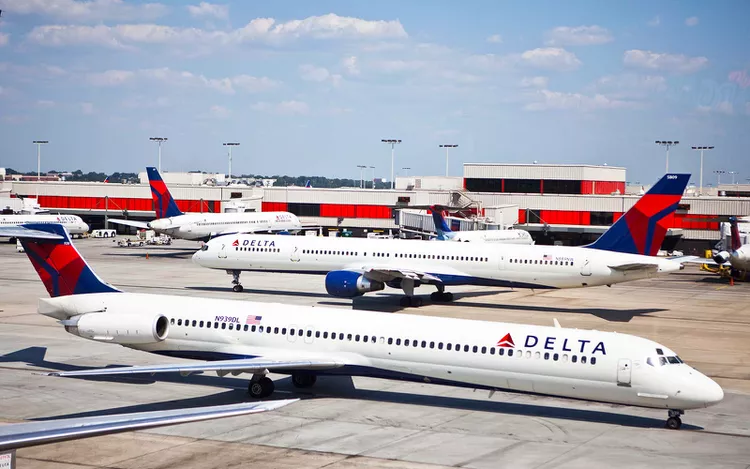Headquartered at the world’s busiest airport, Hartsfield-Jackson Atlanta International, Delta Air Lines is the oldest continuously operated airline based in the United States. It also happens to be one of only four U.S. legacy carriers, including United Airlines, American Airlines, and Alaska Airlines, that survived the economic turmoil that followed the 1978 Airline Deregulation Act.
Today, Delta offers more than 4,000 flights per day between over 275 destinations on six continents. The airline pioneered the hub-and-spoke system — which connects smaller national airports to a single major airport to improve efficiency — now used by many carriers worldwide. Here’s where you can find Delta’s domestic and international hubs, along with insights on which ones to consider for your next journey.
Current Delta Hub Locations
While Hartsfield-Jackson Atlanta International Airport is Delta’s largest hub, the carrier boasts eight others within the United States: Boston Logan International Airport, Detroit Metropolitan Airport, Los Angeles International Airport, Minneapolis-St. Paul International Airport, New York’s John F. Kennedy International Airport and LaGuardia Airport, Salt Lake City International Airport, and Seattle–Tacoma International Airport.
For international travel, Delta’s hubs are located at Amsterdam Airport Schiphol, London’s Heathrow Airport, Paris-Charles de Gaulle Airport, Seoul’s Incheon International Airport, Mexico City International Airport, and Tokyo International Airport (Haneda Airport).
In the U.S., Atlanta is Delta’s busiest hub by far, with over 700 daily arrivals and nearly 800 daily departures to around 150 destinations. This traffic is more than double that of its second-busiest hub, Minneapolis-St. Paul, which sees about 280 arrivals and 290 departures daily. LaGuardia closely follows with approximately 270 arrivals and departures each day. Delta operates more than 400 daily flights to and from both Salt Lake City and Detroit, as well as around 400 flights between JFK and Seattle.
On the international front, Delta’s hubs typically average 20 flights a day each, with Amsterdam securing the highest activity at 17 daily departures and arrivals.
History of Delta Hubs
Since its inception in 1929, Delta has continuously adapted its operations. Originally founded in 1924 as Huff-Daland Dusters, Inc. focusing solely on crop-dusting, the airline has evolved through the decades. Numerous airports have served as Delta hubs, including Germany’s Frankfurt Airport (until 1997), Dallas Fort Worth International Airport (until 2005), Memphis International Airport (until 2013), Cincinnati/Northern Kentucky International Airport (until 2017), and Tokyo-Narita (until 2020). From 1986 until 2001, Portland International Airport briefly functioned as a mini-hub for Delta’s Asia flights.
Delta’s growth in hub acquisition can be attributed to mergers with other airlines. For instance, Minneapolis-St. Paul International Airport was formerly the home base of the now-defunct Northwest Airlines and is now Delta’s third-largest hub. Similarly, the airline inherited Los Angeles and Salt Lake City hubs from its merger with Western Airlines in 1986.
Which Delta Hub Should You Fly Into?
With Delta boasting hubs in numerous major cities in the United States and abroad, the choice of hub often depends on your travel requirements. For East Coast destinations, Atlanta, Boston, or New York City (JFK or LaGuardia) are strategic options. Conversely, if heading to the West Coast, prioritize Los Angeles or Seattle. For inter-coastal flights, Minneapolis-St. Paul, Detroit, or Salt Lake City are excellent choices.
Among the Delta hubs, only two — Minneapolis-St. Paul and Salt Lake City — are featured on the latest rankings of the 10 best domestic airports, while Tokyo-Haneda and Seoul-Incheon are recognized among the 10 best international airports for 2023.
For travelers residing in smaller cities or less populated areas, it may be beneficial to consider a “repositioning flight” or opting for alternative methods such as driving or taking a train to a Delta hub airport for your round-trip journey. This strategy could provide access to more conveniently scheduled or more economical flights compared to flying from a smaller regional airport.
As an illustration, securing a round-trip fare from John F. Kennedy International Airport or Newark Liberty International Airport may prove more budget-friendly than choosing to fly directly from one’s local regional airport. Ultimately, the decision hinges on your travel timeline and budget considerations.




